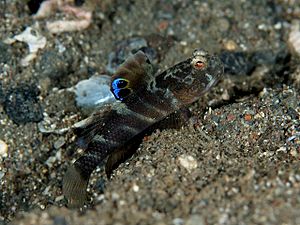Flagfin prawn goby facts for kids
Quick facts for kids Flagfin prawn goby |
|
|---|---|
 |
|
| Conservation status | |
| Scientific classification | |
| Synonyms | |
|
Genus
Species
|
The flagfin prawn goby, also known as the flagfin shrimpgoby or smiling goby, is a small fish that lives in the ocean. Its scientific name is Mahidolia mystacina. This interesting fish is found in the Indian Ocean and the Pacific Ocean. You can find it from places like Mozambique in Africa all the way to the Society Islands and Samoa, and from southern Japan down to northern Australia.
This goby lives in both salty ocean water and slightly salty water (called brackish water). It prefers coastal bays, estuaries (where rivers meet the sea), and the bottom of coral reefs. It likes areas where the seafloor is soft, like mud or silt. These fish usually live at depths of about 5 to 25 meters (about 16 to 82 feet). The flagfin prawn goby can grow to about 8 centimeters (3 inches) long. Sometimes, people keep these gobies in home aquariums. It is the only known species in its group, called a genus.
About the Flagfin Prawn Goby
The flagfin prawn goby has a special way of life. It shares its home with a type of shrimp called an alpheid shrimp. This is a partnership where both animals help each other. The shrimp digs a burrow in the sand or mud, and the goby uses this burrow as its safe home. The goby often acts as a lookout, watching for danger while the shrimp is busy digging. If the goby sees a predator, it wiggles its tail to warn the shrimp, and both quickly hide in the burrow. This type of relationship, where two different species live closely and benefit each other, is called commensalism.
Where the Goby Got Its Name
The name of the goby's group, Mahidolia, was given to honor Mahidol Adulyadej. He was a prince in Siam (which is now Thailand) and was very supportive of fishing and fisheries in his country. He was also the father of two kings of Thailand, King Ananda Mahidol and King Bhumibol Adulyadej.
This fish was first discovered by a scientist named Hugh McCormick Smith. He found it at the mouth of the Chanthaburi River in Chanthaburi Province, which is in Eastern Thailand. This discovery happened in 1932.
See also
 In Spanish: Mahidolia mystacina para niños
In Spanish: Mahidolia mystacina para niños


